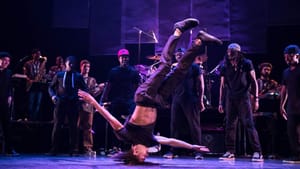Stay in the Loop
BSR publishes on a weekly schedule, with an email newsletter every Wednesday and Thursday morning. There’s no paywall, and subscribing is always free.
Party at Rennie Harris’s
The Kimmel Center presents ‘Rennie Harris: Funkedified’

Dance enthusiasts know hip-hop choreographer and Philadelphia native Rennie Harris best from the rich and thoughtful works he has created for companies such as Alvin Ailey American Dance Theater and our own PHILADANCO. But if you scour the Internet, you can still find clips of Harris in One House Street, his syndicated ’90s TV show featuring hip-hop dance and culture. Funkedified took us further back, to his roots as a North Philly kid in the ’70s growing up with Don Cornelius’s Soul Train on the TV, and brought us along on a nonstop 90-minute social history in dance, from funk to hip-hop.
Welcome to the Mothership
As the house lights fell, a voice announced, “We have taken control of your radio,” echoing Rod Serling’s Outer Limits, and advised us that “the Mothership” had taken over radio transmission, calling back to funk icon George Clinton’s science-fictional alter ego and the prop that accompanied many of his performances.
Onstage, the funk band Invincible (also called the Rennie Harris Funkedified Band), played original music by composer and musical director Darrin Ross, taking us back to Harris’s childhood. Hip-hop hadn’t been born yet and funk ruled. On Soul Train, the Lockers’ new style—locking—lit the way with knee drops and kick splits and gymnastic leaps and tumbling.
The Hood Lockers, with Harris’s Puremovement dancers, brought the Lockers’ style to new life. Harris’s choreography was fun, comical in the exaggerated flow of the loose-limbed movement. The costumes were off-the-rack white shirts, dark pants, and vests, with the pitch-perfect striped knee-high socks that were a trademark of the original Lockers. On a screen of divided panels in the background (projections and visual design by Jorge Cousineau), Philly burned and the police attacked Black protesters, while in the foreground, Joshua “Super Josh” Culbreath challenged the Lockers with lightning footwork. His dark tracksuit signaled the shift in dance and fashion. I loved Culbreath in his own group, Retro Flow (featured in the 2019 Koresh Artist Showcase), and he was just as exciting here.
A solo duet
In the highlight of the evening, dancer and artistic director Leigh “Breeze-Lee” Foaad, in camouflage and a cap, performed a solo that seemed almost a duet with the mournful wail of Matt Dickey’s guitar. The dance, to Eddie Hazel and George Clinton’s “Maggot Brain,” felt like poetry, combining a balletic fluidity with riveting tension. Breeze-Lee’s wave seemed to ripple through the audience and his isolations were off the chart. When Dickey stepped out of the shadows, it became a true duet between the dancer and the guitar. We were breathless. A musical interlude that followed gave us a chance to come back to earth.

What hip hop deserves
With no intermission, the evening progressed quickly through time and styles. The dancers glided impossibly across the dance floor in a variety of steps the Electric Boogaloo called “creeping” before Michael Jackson made it famous as the moonwalk. Popping challenged locking, and breaking borrowed from Brazilian capoeira and took the streets with head spins, leg sweeps, and handstands, punctuated by Shafeek Westbrook’s amazing sequence of flips and tumbling runs. Styles in clothes changed: striped socks to track suits to jeans and tees. Social dance becomes performance, but Harris tells us that hip-hop doesn’t quite catch on as the theatrical dance form it deserves to be. Hip-hop has made it big in the movies and in huge arena concerts, but I understand the desire to see one’s own dance vocabulary take its place next to contemporary and ballet, with the same respect given those forms.
House party pros and cons
Harris promoted the event as kid-friendly and whole families poured in, from grandmothers who remembered when funk was new to tots in their parents’ arms. With small children in the audience and no intermission, there was more than the usual traffic in the aisles, but that just added to a house-party atmosphere that perfectly suited the performance.
Harris billed Funkedified as a multimedia work that set the rise of funk music and street dance of the ’70s against images and narration that reflected the social and political turmoil of the period. Unfortunately, it was impossible to hear Harris’s narration over the music. An occasional phrase broke through during the breakdancing section, but the rest was lost to the amplification of the music. So the dancing was fun and the images striking, but we lost out on Harris’s insights.
What, When, Where
Rennie Harris: Funkedified. Choreography by Rennie Harris. Rennie Harris Puremovement, with the Hood Lockers and the music of Invincible; presented by the Kimmel Center. June 7 and 8, 2019, at the Merriam Theater, 250 S. Broad Street, Philadelphia. (215) 893-1999 or kimmelcenter.org.
The Merriam Theater is a wheelchair-accessible venue with an ADA-compliant restroom accessible by elevator, but the venue may pose challenges for audience members with mobility concerns. For more information about the accessibility of Kimmel campus venues, call Patron Services at (215) 893-1999 / (215) 875-7633 TTY or email [email protected].
Sign up for our newsletter
All of the week's new articles, all in one place. Sign up for the free weekly BSR newsletters, and don't miss a conversation.

 Camille Bacon-Smith
Camille Bacon-Smith